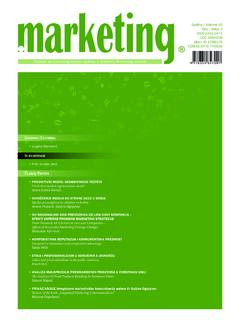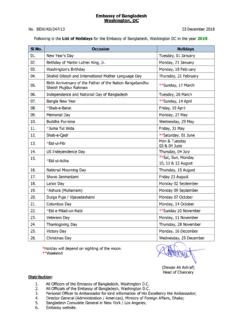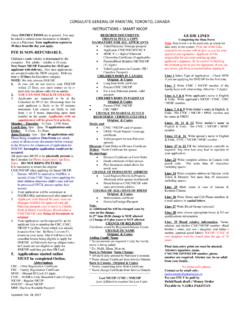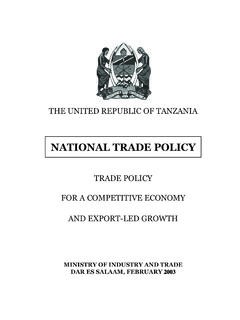Transcription of Locatives in Bantu (Draft, 2017) - Jochen Zeller
1 Locatives in Bantu ( draft , April 2017) Jochen Zeller 1. Introduction This chapter is concerned with Locatives and locative formation in the Bantu languages. Section 2 illustrates how Locatives are derived in Bantu , focusing primarily on locative formation by means of locative noun class prefixes and suffixes. Section 3 examines the agreement properties of Locatives with respect to locative internal modifiers and locative . external predicates. The syntactic representations that have been proposed for different types of Locatives in Bantu are the topic of section 4. Finally, section 5 discusses the thematic role and grammatical function of Locatives , and ends the chapter with some brief remarks on locative applicative, locative shift and locative inversion constructions. 2. The formation of Locatives Locative noun classes The most common way of deriving a locative from a non locative noun in the Bantu languages is by means of the noun class markers of class 16, 17 or 18, which have been reconstructed for Proto Bantu as *p (class 16), *k (class 17) and *m (class 18) (Maho 1999; Meussen 1967).
2 These markers are prefixed to the base noun, whose original noun class marker is preserved. Locative formation by means of noun classes 16 18 is the rule in the central Bantu region, but locative systems based on these classes are also found in Northeastern and Southern Bantu (Ru i ka 1959; Gr goire 1975). (1) and (2) provide examples of Locatives in all three classes, based on a singular (1) and a plural (2) base noun respectively:1 (1) a. pa n g nd b. k n g nd c. mu n g nd 9 house 9 house 9 house 'at the house' 'to the house' 'in the house' [Bemba M42; Marten 2012: 433] 1. In this chapter, I refer to languages by the name and Guthrie code listed in Maho (2008, pp. 53 78). Linguistic examples are glossed as follows: APPL = applicative; ASP = aspect; ASS = associative, AUG = augment; DEM = demonstrative; DJ = disjoint verb form; FOC = focus; FUT = future; FV = final vowel; HAB = habitual; INF = infinitive; LOC = locative; OM = object marker; PFV = perfective; PRF = perfect; PRO = pronoun; PRS = present; PST = past; REL = relative; SIT = situative; SM = subject marker.
3 I have occasionally added glosses to examples adopted from the literature, or adjusted glosses provided in the original source to my system. High tone is marked by an acute accent; low toned (toneless) syllables are unmarked (but notice that not all examples are consistently marked for tone in the original source). Throughout this chapter, I refer to any linguistic element that refers to a spatial location as a "locative expression". I will reserve the term "locative" for the combination of a nominal element and a specific locative marker (typically a prefix or a suffix). 1 (2) a. p m bok b. k m bok c. m m bok 6 arm 6 arm 6 arm 'on the arms' 'against, on the arms' 'in the arms' [Luba Kasai L31a; Kuperus & Mpunga wa Ilunga 1990: 10 (glosses added)] As the translations in (1) and (2) show, the specific meaning expressed by a particular locative class may differ from language to language, and can usually only be determined when the semantics of the whole construction is taken into account (see Haddon 1951; Taylor 1996, 2007 for discussion).
4 Consequently, there are few studies which attempt to provide a fine grained semantics of locative prefixes in Bantu languages (but see Barlew 2013; Fleisch 2005, and Chapter 28). However, it is possible to identify certain general, prototypical locative meanings2 associated with the three locative classes. Class 16 typically has an adessive meaning; it expresses close relative proximity, or attachment with contact, and is also used to refer to specific locations. Class 17 is the semantically least specific locative class; it denotes a general location or further relative proximity, and when used with motion verbs, it often translates as "towards" or "from". Class 18 has an inessive meaning and expresses interiority. The locative prefixes of class 16 18 always precede the class prefix of the base noun with which they combine, as well as other "secondary" derivational prefixes, such as the diminutive or the augmentative.
5 However, Bantu languages vary with respect to whether the so called augment, or pre prefix (see Chapter 14), of the base noun remains part of the derived locative. In Bemba, for example, this is not the case; although nouns typically take an augment in Bemba (the base noun from which the Locatives in (1) are derived is inganda in its non locative form), the augment is lost in when the locative prefix is attached. In contrast, the base noun's augment is preserved in Locatives in Herero (R30): (3) a. pondj w b. kondj w c. mondj w pu o n dj w ku o n dj w mu o n dj w AUG 9 house AUG 9 house AUG 9 house at a/the house' to(wards) a/the house' in a/the house' [Herero R30; M hlig & Kavari 2008: 89; Gu rois 2016: 46] There is also variation with respect to whether Locatives themselves can take an augment. In Lamba (M54), this is not possible; for example, the noun icipuna, 'stool' becomes pacipuna in class 16, and an "augmented" locative form such as *apacipuna does not exist (Ziervogel 1971: 371).
6 In contrast, in Haya (JE22), class 16 18 Locatives appear with their own augment; compare ahakitooke, 'on the banana'; omukyaalo, 'in the village' (Trithart 1977: 90). Gr goire (1975) concludes that Locatives in Proto Bantu included two augments, one for the base noun and one for the locative, and she suggests that some Bantu languages may even have preserved both (compare Kinande (JD42) okony mba, o ku o ny mba, 'at the house'; Gr goire 1975: 164). 2. Bantu Locatives are also used to refer to location in time or to express partitivity (see Chapter 28). For reasons of space, I do not discuss these meanings of Locatives in this chapter. 2 The class 16, 17 and 18 locative markers are not only used as secondary prefixes, but can also function as primary noun class markers with a small set of nominal stems. The most common locative nouns are those based on the stems * ntu and * j ma, meaning 'place' (Meeussen 1967: 103; Schadeberg 2003: 82): (4) a.
7 P nt place 'on a place' b. k nt place 'somewhere, elsewhere' c. m nt place 'somewhere inside' [Luba Kasai L31a; Kuperus & Mpunga wa Ilunga 1990: 37 (glosses added)] (5) a. h ma h ma place my b. k ma kw ma place my c. m ma mw ma place my 'at my place' [Suku H32; Gr goire 1975: 16 (glosses added)] In some eastern Bantu languages, these locative nouns occur in pairings, in Kamba (E55), where class 16 v ndu, 'place', takes its plural k ndu, 'places', in class 17 (Ru i ka 1959: 628; Maho 1999: 197). According to Gr goire (1975), the existence of locative nouns of class 18 is a characteristic feature of the central Bantu languages; they are rare outside this region. In a number of Bantu languages of zones D, H, K, L and M, the locative prefixes of class 16, 17 and 18 are replaced by the bimorphemic forms *p d , *k d , *m d in certain contexts. According to Gr goire (1975: 19), these forms are derived from Proto Bantu relative constructions based on locative nouns, viz.
8 *pantu p d , *kuntu k d , *muntu m d , 'the place which is ' ('l'endroit o est'). The bimorphemic forms are used, for example, with augmentless nouns in languages in which nouns normally require augments (compare Bemba kuli kafundisha, 'at the teacher's'; Gr goire 1975: 20). A special class of locative expressions is derived from relational nouns (often referring to body parts) which denote what Jackendoff (1996) and Marr (1982) refer to as the "axial parts" of an object, its front, back, bottom sides Gr goire (1975) calls these locative expressions "restricted Locatives " ("locatifs restreints"). A restricted locative is typically 3. See Svenonius (2006), who analyses expressions of this sort as exponents of a special functional category AxPart. 3 followed by a satellite noun which is linked to the preceding locative via the associative or comitative marker: (6) k ny ma kwaa nzub 17 'behind the house' [Luba Kasai L31a; Kuperus & Mpunga wa Ilunga 1990: 41] (7) mu maaso g'enjo 'in front of the house' [Luganda JE15; Haddon 1951: 100 (glosses added)] Based on Gr goire (1975), Kuperus & Mpunga wa Ilunga (1990: 39) list the following twelve basic locative relations that are typically expressed by restricted Locatives in Bantu : "above, on", "below, under", "in front of", "behind", "beside", "to the right of", "to the left of", "inside", "outside", "near to", "far from" and "at X's place, chez, at home".
9 The locative noun classes also include pronominal forms. Ru i ka (1959) lists numerous examples, from different Bantu languages, of locative pronouns in classes 16, 17 and 18. Compare Nyanja (N31a): (8) a. apa 'here'; apo 'there', pano 'at (t)here'; paja 'yonder'; pati? 'where (at, on)?' b. uku 'thereto', uko 'there', konse 'everywhere', kuno 'to here', kodi? 'where?' c. muno 'in here', umu 'herein', muja 'yonder', momwe, momo 'therein, thereupon' [Nyanja N31a; Ru i ka 1959: 605 6; 612; 619] In addition, many Bantu languages have locative enclitics with pronominal reference: (9) Ink yaguuyem . i n k i a gu ye=m AUG 9 cow PST fall PFV= 'A cow fell there.' [Kinyarwanda JD61; Ngoboka 2016: 92] While the three locative noun classes 16 18 are used with much regularity in the central Bantu domain, certain classes are no longer productive in languages outside this area. Reduced locative systems are found particularly in the J languages.
10 For example, class 16 is no longer used as a derivational class in Kinyarwanda (JD61) and Kirundi (JD62); Luganda (JE15) has lost productive secondary prefixes of classes 16 and 18, and Haya (JE22), Kerewe (J24), Nkore (JE13) and Nyoro (JE11) no longer have a productive class 17 prefix (Gr goire 1975: 72 3). The J languages also belong to the class of Bantu languages in which a fourth locative noun class exists. Locatives in this class are formed with the prefix i or e , and Meeussen (1967) postulates a corresponding Proto Bantu locative noun class prefix *i. In Maho's 4 (1999) words, "[t]he labelling of this particular locative class is a mess": for example, Katamba (2003) refers to it as class 23, Meeussen (1967) calls it class 24, and in Gr goire (1975), it is labelled class 25. (I adopt Gr goire's label in this chapter). Class 25 is mainly found in the northeastern Bantu area (Zone J), where it is common with place names, in the southern Bantu Nguni languages (S40), and in a few Northwestern languages of Zones A, B and C (Gu rois 2016):4 (10) i Kigal 'in Kigali' [Kinyarwanda JD61] (11) e m kethe 'at the market' [Zulu S42] Another locative prefix, which is found exclusively in Southern Bantu (Venda, Tsonga, northern Nguni and partly in Sotho), is the prefix ka (and its cognates), which typically combines with [+human] nouns to express the meaning of "at X's homestead/village/residence" (G ldemann 1999): (12) k m f ndisi LOC 1 minister 'at the minister's residence' [Swati S44.]





